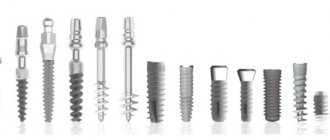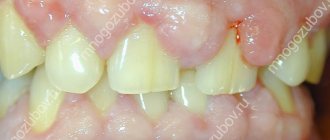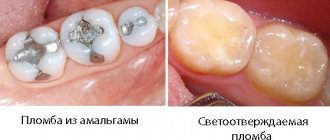Content
- Causes of destruction
- Activities before treatment with a doctor
- Temporary filling fell out
- A permanent filling fell out
- Price
- Prevention of destruction
No one is safe from falling out or partial chipping of a filling. The patient experiences discomfort. This is both a moral component and very real inconvenience. The problem becomes the inability to chew food normally, excessive tooth sensitivity, even pain. You need to contact a specialist immediately to stop tooth decay and restore its normal functions.
PROMOTION
Dental restoration, installation of fillings
from 2200 rub.
Treatment
For the patient, the size of the damage does not matter - part of the filling has fallen out or all of it has left the tooth, the main thing is to restore integrity and prevent further destruction and infection of the tissue.
This is what the doctor will do at the appointment. Only he can decide to what extent the intervention will be carried out on hard and soft tissues, as long as everything is done reliably and aesthetically:
- If there is a significant carious cavity, in order to avoid a repetition of what happened, the doctor may suggest making an artificial crown.
- If pulpitis is detected, this disease will first need to be treated and only then can the filling be restored.
- In a pulpless tooth, it is possible to use a pin insert to solve the fixation problem - a metal rod is placed in the root canal, on which the filling is strengthened; it is no longer possible to loosen it.
- Eliminating periodontitis takes the most time. It is usually carried out in several visits, and this is where the use of temporary fillings is required, because poor-quality treatment of periodontitis will lead to tooth extraction, which will create new problems for the patient - this time with prosthetics.
Activities before visiting the doctor
You must make an appointment with a specialist as soon as possible. However, it happens that it is not possible to visit a doctor in the near future. Simple recommendations will help maintain the integrity of the tooth while waiting for an appointment. There is no point in delaying treatment, as an open tooth can easily become infected, which will lead to unpleasant and even dangerous consequences. What the patient can do:
- Eliminate or minimize the load on the affected tooth.
- Do not chew hard food.
- Rinse thoroughly, do not allow plaque to accumulate.
- If your tooth hurts, you can take a pain reliever.
- Do not plug the cavity with improvised materials. This will create a favorable environment for the proliferation of microbes and can lead to tooth infection.
Sealing of water meters
To recalculate water payments, it is necessary not only to install meters, but also to seal them. The sealing procedure is mandatory for registering a measuring device. If this measure is not taken, you will continue to pay standard water rates (based on a fixed price per person).
The sealing procedure is carried out only by those companies that have the right to draw up acts for submission to the registration authorities. Before installing the seals, the specialist inspects the device, checks whether the water meters are connected correctly and whether they are damaged. He also gives the owner of the meter a technical passport of the product and other necessary documents for its registration.
The Law “On Water Supply and Sanitation” states that payment for sealing the meter is not made during initial installation, after inspection and repair. An exception is the replacement of a device that has failed due to the fault of the user.
What to do if a temporary filling falls out
The material of permanent fillings can be destroyed under the influence of applied force. Temporary material is not designed to withstand loads at all; it is very fragile, soft, and easily chips. As a rule, such fillings are installed for a short period between visits to the dentist. For example, after treatment and filling of canals before installing a permanent filling. Its function is to prevent saliva and food from getting inside the tooth.
If a filling falls out, it is better to inform the doctor about it, the specialist will tell you whether it is worth coming for an unscheduled appointment or whether you can wait for the scheduled visit.
Tooth restoration
No matter the scale of the tooth chipping, go to the dentist! There are no traditional methods or glue that can glue part of a tooth together. Only an experienced doctor can choose a treatment tactic.
The following options exist:
Small chips may not even need to be filled. Modern dentistry provides the most gentle way to restore tooth integrity.
For moderate damage, you will need to use a drill and install a filling, and sometimes build up a tooth.
In case of severe damage: installation of veneers, pins, crowns, inlays.
In particularly difficult cases, if the chip goes directly into the gum, the tooth may be removed.
What to do if a permanent filling falls out
When a filling falls out, there is a real risk of infection and the development of recurrent caries. Another problem is tooth decay, since the walls of the cavity receive excessive force. The tooth will inevitably begin to decay. Therefore, visiting a specialist as soon as possible is the only correct option in such a situation. The patient can avoid the negative consequences of a filling falling out in several ways:
- Do not put any stress on the affected tooth.
- Avoid aggressive influences - sour, sweet, salty, hot and cold.
- Ensure thorough hygiene, remove food debris and plaque.
- Rinse the tooth.
- Make an appointment for a follow-up appointment immediately.
Prevention of filling loss
The following recommendations from dentists will help reduce the likelihood of a filling falling out:
- It is very important to treat teeth in a timely manner, then the inserted fillings will have sufficient support, and the risk of their loss is significantly reduced.
- You should not change sharply hot food to cold food; such a contrast has a bad effect on tooth enamel and the condition of fillings.
- Avoid putting excessive stress on your teeth.
- Be sure to regularly maintain oral hygiene.
- Visit the dentist regularly (at least 2 times a year).
- It is worth giving up solid foods and sticky sweets.
- You need to eat foods high in calcium as much as possible.
If fillings regularly fall out, you should probably change your doctor.
The cost of installing different types of fillings
The price of a filling depends on the filling material and the amount of work the dentist does. For example, treatment and filling of canals, installation of pins and other auxiliary systems increase the cost. Modern high-tech fillings - a light-curing composite - will cost from 1,900 rubles, taking into account all additional steps for preparing the tooth and final polishing. The use of a fluid composite during layer-by-layer polymerization will add 1000 rubles to the cost; a fluid composite in combined fillings will cost 400 rubles. The cost of a temporary filling is from 200 to 500 rubles, depending on the material. Installation of a pin for durable installation of the seal, if necessary - from 1,500 rubles.
Causes of fillings falling out
- An incorrectly formed, poorly dried, or insufficiently etched carious cavity with a special compound could lead to the filling falling out.
- In preparation for filling, the cavity was not sufficiently cleaned of dentin; because of this, the filling material did not adhere tightly to the walls of the tooth and the destruction process continued under a fresh filling.
- Improper treatment of the edges of the carious cavity created conditions for chipping of the enamel, as a result of which the fixation of the filling was not tight enough. During chewing, pressure is applied to the tooth, which causes the filling to become loose and fall out.
- The seal itself was installed in violation of the technology, or from material with an expired shelf life. If the filling occupies a large area of the chewing surface of the tooth, then the walls around it may also collapse, depriving it of support.
- Premature loss may be associated with the consumption of solid foods: crackers, nuts, viscous sweets.
Important! Fillings in children often fall out due to the characteristics of the filling material. This material is completely safe and non-toxic for baby teeth. Without chemical adhesion, the children's filling is not fixed tightly, which leads to its loss.
Sealing of electricity meters
Electricity meters are necessary to account for the electrical energy consumed by residents. Since this data is under the control of energy supply organizations, metering devices undergo a sealing procedure. The installed seal serves as a guarantee that the consumer does not interfere with the metering process and cannot influence the meter data.
New measuring instruments have a factory seal. After the meter is subjected to a repeated verification procedure, a new sealing device is placed on it with the stamp of the state verifier.
Some companies use self-adhesive seals for sealing with the logo of the organization that carried out the inspection. Anti-magnetic devices are also quite often used, which detect attempts to change meter data using a magnet. If a violation is detected, the sticker changes color, and this process is irreversible.
We invite you to familiarize yourself with Yellow plaque on the back of the throat
The meter is sealed after submitting an application to the Distribution Zone. The application must state the reason for installing a new seal (replacing a device, changing its location, replacing wiring).
Technology
Filling placement is the most common dental service. However, it requires a highly qualified doctor. The procedure takes place in several stages:
- X-ray diagnostics. From the image, the dentist determines the depth, type and extent of the lesion.
- Anesthesia. An injection is used to relieve toothache. First, the gums are anesthetized with application, then an injection of infiltration anesthesia is given. The conductor method is less commonly used.
- Preparation. The tooth is cleaned with a drill from tissues affected by caries. Air-water cooling is required to avoid overheating of the tissues. If the patient has pulpitis, the nerve is removed, followed by filling of the canals. The last procedure is carried out in several stages with a break of a couple of days.
- Removing overhanging edges. Excessively thin walls that cannot withstand the load are removed with boron, even if they are healthy.
- Preparing the cavity. It expands, irregularities and sharp elements are smoothed out. Then the cavity is given a certain shape: triangular, trapezoidal, conical, cruciform, rectangular. This is necessary for a stronger fixation.
- Disinfection. The cavity is treated with antiseptics and dried.
- Isolation from other teeth. A rubber dam - a latex handkerchief - is fixed to the prepared unit using an iron clamp. It will prevent liquid from entering the treated area.
- Installation of insulating and antimicrobial gaskets. They need to be placed to prevent communication of the cavity with other tissues and the spread of infection.
- Adhesive treatment. Necessary for better adhesion of the filling material to the walls.
- Direct installation. Cementitious materials are applied at one time. The dentist should be able to completely restore the crown in a couple of minutes. The composites are installed in stages, each layer is treated with a curing lamp. Hardening time is from 20 to 40 seconds.
- Bite check. The doctor asks the patient to bite the carbon paper - the protruding and excess areas will become colored. Afterwards they will be removed with a drill.
- Grinding and polishing. The filling is ground down, unevenness and roughness are removed. If necessary, it is coated with a protective varnish.
Types of damage
There are several types of dental injuries with fractures. The classification sign is the depth and degree of injury.
Enamel chip or microcrack
In this case, the integrity of the upper layer of hard tissue is compromised - it cracks, or a small fragment separates. Usually such problems are invisible and do not cause discomfort. These are minor defects that can be quickly treated, but people do not rush to the dentist with them, which is a serious mistake.
What to do if part of a front tooth or a piece of a back tooth chips or falls out? It is important to visit a dental clinic as soon as possible. Damaged structures will become a place for the spread of pathogenic microflora, which will provoke the development of caries and other diseases. In addition, the load when chewing food will increase significantly, so half of the crown may fall off at any moment.
Chip with dentin fracture
Dentists classify this type of damage as moderate. Symptoms may be pronounced or completely absent. If the dentin layer is not restored, the unit will gradually crumble and soon fall apart. In addition, the smile will become unattractive, especially if a piece of an incisor is missing.
Deep fracture to the pulp tissue with exposure of the nerve
This is a severe injury with serious symptoms such as bleeding and severe pain. Even strong painkillers help dull unbearable sensations only for a short time. The crown may be missing half or more. If you are late with medical intervention, the risk of infection, inflammation and other pathological processes that are difficult to treat increases significantly.
Requirements for sealing meters in the regulations of the Russian Federation
The legislative acts of the Russian Federation contain provisions that all energy metering devices must be checked and sealed after installation. This is a necessary measure to prevent unauthorized access to the internal elements of devices. The law also stipulates that meters that have not passed the sealing procedure are not allowed to register. This means they cannot be used for their intended purpose.
Access control devices must be installed by utility companies. The service is free and mandatory. Charging a fee for sealing a meter is considered an administrative violation. For this, management companies are fined up to 20,000 rubles, and officials - up to 2,000 rubles.
Chipping of a filling on the central teeth or on the edge of a tooth
If a filling on a front tooth falls out, the reason for the appearance of this condition is excessive load on the tooth or the development of secondary caries.
When a patient’s tooth is not completely destroyed, there is no caries, or the tooth is chipped at the edge, the specialist will correct the problem in one visit.
But if there is a pathological process in the oral cavity, then eliminating the aesthetic defect will take a long time. The doctor will need a whole range of measures to restore the dental crown:
First of all, the specialist will carry out a set of measures to sanitize the oral cavity. The concept of sanitation includes: elimination of cariogenic foci of bacterial growth; re-treatment and filling of canals in the tooth where the filling has fallen out; elimination of inflammation in the entire oral cavity.
Secondary caries under poor quality filling
Selection of materials for restoration. If a tooth has broken off at the edge, then polymer photographic materials are suitable for restoration. But if a significant part of the tooth breaks off along with the filling, the doctor will suggest installing a filling on a pin or a crown.
Often, specialized orthopedic onlays - veneers - are used for the front teeth. They help correct the shape of the tooth and restore the chipped area. The aesthetic and chewing function of veneers is ensured by the material from which they are made. Veneers are made from zirconium dioxide, they are strong and can last for decades with proper care.
When you don’t know what to do if part of the central tooth with a filling has broken off, then the best decision would be to immediately contact the dentist.
Temporary compositions
All temporary structures are called temporary because they are installed for a short period of time. Often temporary fillings are placed for either a few days or a few weeks. The maximum period for installing temporary fillings is six months.
Part of the metal-ceramic crown broke off
There are several reasons for temporary fillings to chip and fall out:
- Using toothbrushes with hard bristles and using an irrigator.
- Eating sticky and overly hard foods.
- Use of low-quality filling material.
- Expired materials.
- Expiration of the period of stay of the filling in the tooth cavity.
Temporary filling is used for:
- Closing the tooth cavity during root canal treatment and removing inflammation at the apex of the tooth root. Anti-inflammatory and disinfectant drugs are placed into the tooth, and the cavity is closed with a temporary filling.
- Closing the tooth cavity during complicated treatment. When a specialist needs several days for complete treatment.
Temporary filling in a tooth
Temporary compositions differ from permanent materials in their fragility, because they are used only to temporarily cover the tooth cavity. And the use of durable cement in this case is impractical.
If a temporary filling breaks off, the patient will not be able to do anything on his own; a visit to the dentist is a mandatory event.
Measures before a visit to a specialist and prevention of premature loss of compounds
General recommendations when a filling falls out:
- Eliminate the load on the crown. If the damage is significant and the walls of the crown are weak, then it is necessary to completely eliminate pressure on it. You need to chew on the other side.
- You should not eat sticky sweets or colored foods. After filling the walls with a polymer filling composition, the enamel may differ from neighboring crowns due to the dentin previously stained with the products.
- Rinse your mouth with medicinal herbal decoctions, rinse with antiseptic solutions.
- You can make your own antiseptic rinse using baking soda. Be careful during hygiene procedures and do not use excessive force when cleaning.
If your tooth hurts after a filling falls out
In most patients, when the filling material falls out, there is a sharp and severe pain syndrome. Often the pain is unbearable and painkillers do not provide long-term relief.
The crown of a tooth fell out
If the patient does not have the opportunity to urgently go to the dental clinic after a piece of the filling has broken off, then the following recommendations will help to eliminate pain:
- Use of painkillers. But you should not overdo it with their use, as the drugs can be addictive or lead to irreversible processes in the body.
- Rinsing the mouth with medicinal infusions and soda. An infusion of chamomile and sage will help relieve inflammation of the mucous membranes and slightly soothe the inflamed pulp. And rinsing with baking soda and salt will help keep your mouth clean. Soda reduces the growth of cariogenic microorganisms and helps normalize the acidity of the oral cavity.
- If taking medications with an analgesic effect does not bring relief, then topical use of novocaine solution is recommended.
- A ten percent solution of novocaine is used as a mouth rinse or the solution is applied to a sterile cotton pad and applied to the affected areas.
- It is necessary to keep parts of the body warm. If your feet get too cold or another part of the body gets cold, the inflammatory process in the chipped tooth will develop into a purulent abscess, which will require emergency measures. You can’t apply heat to the tooth; bacteria will receive favorable conditions for development. And the pain will continue with renewed vigor.











